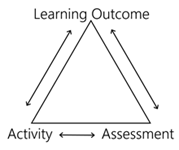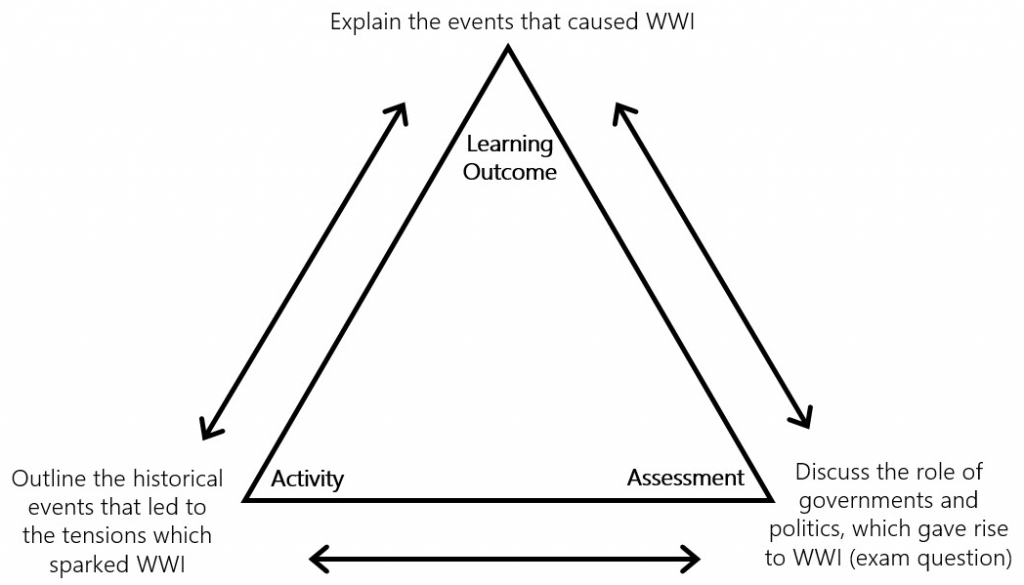Why do I need learning outcomes and how are they used to design a solid course?
When thinking about designing and developing a course, an instructor must consider:
- learning goals, student learning outcomes, and instructional objectives;
- assessments and feedback; and
- instructional strategies, learning activities, and resources.
Consider learning outcomes, assessments, and activities that support one another in order to provide students with the best opportunity to learn.
This resource will explain what alignment is in course design and what to look out for in order to create a well aligned course.
The Alignment Triangle

Alignment in course design means that the outcomes, assessments, and activities all support one another. It is often depicted as an isosceles or equilateral triangle. If one part of the triangle is absent or is not supportive of the other parts, the triangle will collapse or will look different than the intended triangle.
This is often referred to as constructive alignment (Biggs, 1996). This learner-centered instructional approach focuses on what “the learner has to achieve and how the learner may best be engaged in order to achieve it to the required standard” (p. 6).
- Learning Outcomes:
- Learning outcomes guide the selection and design of learning activities and assessments.
- Assessments:
- Assessments are in alignment when they assess whether or not a student can achieve the specific outcome.
- Activities:
- Activities and resources are in alignment when they provide students the best opportunity to learn what is specified in the learning outcome.
Ensuring Alignment
A good learning outcome contains a verb that can guide the selection or creation of activities that students need to engage with to achieve the outcome. The same verb can guide the selection or creation of assessments that can measure how well students achieved the outcome and facilitate appropriate feedback.
It is critical that learning activities, including skills practice, match the learning outcome and that assessments measure what students learned and practiced. After reviewing the course, you may discover that you have an activity or assessment that is not aligned with the outcomes. You may need to modify the activity or assessment to reflect the outcome or you may end up revising the outcome.
Note
Some textbooks and associated publisher resources come with learning outcomes or objectives. Review all outcomes and objectives carefully to ensure alignment and appropriateness for your course.
Example
Here is an example of this relationship between these three components affecting each other.
- The learning outcome, or objective of a lesson is to explain the events that caused World War I.
- The activity for the lesson is to outline the historical events that lead to the tensions which sparked the First World War.
- The assessment of this lesson comes in the form of an exam question, which asks students to discuss the role of governments and politics which gave rise to the First World War.

Resources
- Biggs, J. ( 1996). Enhancing teaching through constructive alignment. Higher Education, (1)32, 347-364. https://doi.org/10.1007/BF00138871
- Dick, W., Carey, L., & Carey, J.O., (2001). The Systematic Design of Instruction. 5th Edition. New York: Longman.
- Gronlund, N. E., & Brookhart, S. M. (2009). Writing Instructional Objectives (8th Edition). Upper Saddle River: Pearson Education Inc.
- Krathwohl, D. R. (2002). A revision of Bloom’s taxonomy, an overview. Theory into Practice (41)4, 212-219.
Originally Published: June 8, 2018



